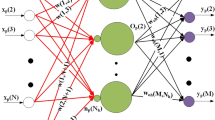Abstract
Recently it was pointed out that a well-known benchmark data set, the sonar target data, indeed is linearly separable. This fact comes somewhat surprising, since earlier studies involving delta rule trained perceptrons did not achieve the separation of the training data. These results immediately raise the question of why a perceptron with a continuous activation function may fail to recognize linear separability and how to remedy this failure. The study of these issues directly leads to a performance comparison of a wide variety of different perceptron training procedures on real world data.
Similar content being viewed by others
References
Bouten, M., Schietse, J. and Van den Broeck, C.: Gradient descent learning in perceptrons: A review of its possibilities, Physical Review E 52 (1995), 1958–1967.
CMU Neural Networks Benchmark Collection, Sonar, mines vs. rocks, available from ftp://ftp.cs.cmu/afs/cs/project/connect/bench/, 1988.
Cortes, C. and Vapnik, V.: Support-vector networks, Machine Learning 20 (1995), 273–297.
Fahlman, S. E.: Faster learning variations on backpropagation: An empirical study, In: D. Touretzky, G. Hinton and T. Sejnowski (eds), Proc. of the 1988 Connectionist Summer School, Morgan Kaufmann, San Mateo, CA, 1989, pp. 38–51.
Gorman, R. P. and Sejnowski, T. J.: Analysis of hidden units in a layered network trained to classify sonar targets, Neural Networks 1 (1988), 75–89.
Minsky, M. and Papert, S.: Perceptrons, MIT Press, Cambridge, Mass., 1988.
Riedmiller, M. and Braun, H.: A direct adaptive method for faster backpropagation learning: the RPROP algorithm, In: Proc. of the IEEE International Conference on Neural Networks, IEEE, Piscataway, NJ, 1993, pp. 586–591.
Rosenblatt, F.: The perceptron: A probabilistic model for information storage and organization in the brain, Psychological Review 65 (1958), 386–408.
Ruján, P.: Playing billiards in version space, Neural Computation 9 (1997), 99–122.
Solla, S. A., Levin, E. and Fleisher, M.: Accelerated learning in layered neural networks, Complex Systems 2 (1988), 625–640.
Torres Moreno, J. M. and Gordon, M. B.: Characterization of the sonar signals benchmark, Neural Processing Letters 7 (1998), 1–4.
Watkin, T. L. H.: Optimal learning with a neural network, Europhysics Letters 21 (1993), 871–876.
Widrow, B. and Lehr, M. A.: 30 years of adaptive neural networks: Perceptron, madaline and backpropagation, Proc. IEEE 78 (1990), 1415–1442.
Author information
Authors and Affiliations
Corresponding author
Rights and permissions
About this article
Cite this article
Hasenjäger, M., Ritter, H. Perceptron Learning Revisited: The Sonar Targets Problem. Neural Processing Letters 10, 17–24 (1999). https://doi.org/10.1023/A:1018654611986
Issue Date:
DOI: https://doi.org/10.1023/A:1018654611986




